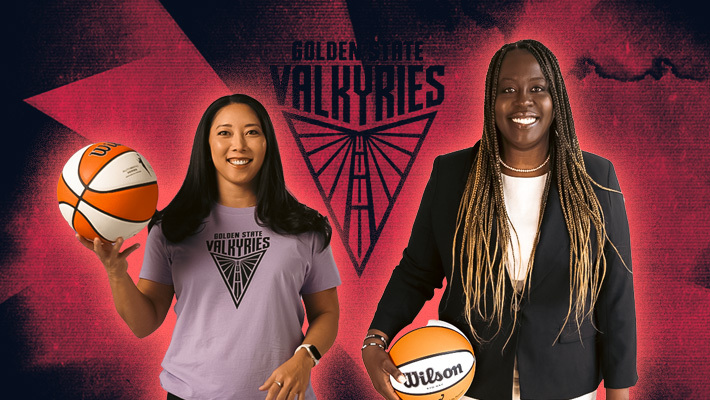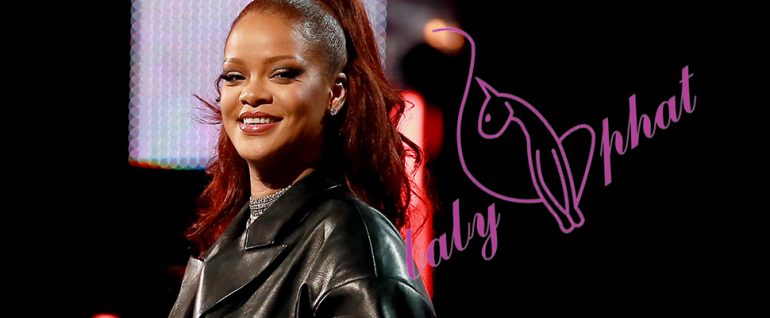-
 play_arrow
play_arrow
DisnDat HITZ DisnDat HITZ
-
 play_arrow
play_arrow
Warlando Hitz Warlando Hitz
-
 play_arrow
play_arrow
DisnDat Tunez Reggae,Dancehall and Afro Beats
-
play_arrow
Allow Us to Re-Introduce Ourselves
The Golden State Valkyries are the first expansion team to join the WNBA since the Atlanta Dream in 2008, and while they will soon be joined by the Toronto Tempo and a Portland franchise in 2026, the franchise has to go through the expansion process without much of a blueprint.
Leading the way in constructing this brand new team are general manager Ohemaa Nyanin, head coach Natalie Nakase, and VP of basketball operations Vanja Černivec. Nyanin has been in the Bay Area since May, with Černivec joining the front office in July and Nakase being hired as head coach in early October, and for all of them, Dec. 6 was circled on their calendars upon arrival. That was when they would add the first players to their roster in the expansion draft, with the option to select one player from each team that was not on their protected list of six players.
Ultimately, the Valkyries selected 11 player in the expansion draft, opting largely for veterans and taking their upside swings on international players who aren’t guaranteed to come over to the WNBA. Only one selection, Kate Martin, is on a rookie contract. The day after the expansion draft, we got a chance to sit down with Nyanin and Nakase, separately, over Zoom and discuss the draft and their overall approach to team-building as they go through one of the most unique experiences in sports: building a team from scratch.
For Nyanin, the expansion draft was the culmination of a 7-month process in which she poured over the rules, read them every day, and did mock drafts every other day — “Excel and I became best friends,” she says.
With teams not providing their protected player lists until the week of the draft, Nyanin and the Valkyries front office had to game out what the possibilities would look like. For most teams, mapping out the first four or five players on the protected lists was easy, but the last two protected players were much more likely to be in flux, so they were constantly going through discussions on different iterations of what their options could be.
“A lot of lists — if they protected this person, discuss, watch film, rinse and repeat,” Nyanin said of the preparation process. “And we did that for a really long time, and we had a lot of passionate conversations, because we all come from different experiences, and we just wanted to do right by our team. And what was really helpful was we have some core principles that we already know are non-negotiables amongst the three of us.”
The trio made it a point to view every player through the lens of those core principles, which and encompassed both skills and intangibles. Nyanin highlighted three things they focused on when discussing and watching players: Defense, attention to detail on offense, and who they are as players.
“The three things that we talk about ad nauseum, [first] is defense,” Nyanin explained. “Do they have some type of … how can they affect the game? We always talk about how athletes can’t do something, but how can they do X? And can coach Natalie put them in whatever system that she’s putting together? The second thing was attention to detail on offense. What can they do on offense that would be dynamic enough to be able to, if nothing else happened in the future, that you could be able to use them in different spaces?
“And the one that’s the most important is, who are they as individuals. We didn’t get the opportunity to talk to any of them prior to selecting them. And you know, we watched their demeanor on film. I have extended experience with the Liberty coach, Natalie with the Aces, so we knew the type of athlete that we’re looking for, somebody who wasn’t afraid of this experience. And so those are the three that we’re highlighting right now, but there’s definitely a lot more behind the scene.”
Nakase offered a bit more detail regarding the “who they are as individuals” piece, noting she needed players to exhibit three traits on the floor. The first is ultra-competitiveness, players who “love winning but hate losing” stick out in particular. The second is high character, those that will put the team first and “sacrifice for the greater good of the team.” The third is to never be satisfied, and to constantantly “play as if they have a chip on their shoulder, or if they have something to prove.”
Identifiying those traits is especially difficult when you can’t sit down and talk with players, so they poured over film and leaned on their experiences in New York and Las Vegas. Given those non-negotiables, particularly when it came to intangibles, it shouldn’t be a surprise they went with more veteran players — who have more film and intel available — with the lone player on a rookie deal being Martin, who Nakase coached.
Typically, when we think of building a team, it starts with stars and you add players that complement their strengths. Because of how they had to build out their roster, the Valkyries have to do the opposite, as teams will protect their best players in an expansion draft and you are adding, largely, role players first. I asked Nyanin whether the order of operations in how they would have to construct this roster challenged the way she thinks about team-building, or forced her to consider it in a different way.
“I think I’m already thinking about team building a different way, not because of what the process is, but based off of my experiences,” Nyanin explained. “So, I’m a walk-on. I hang my hat on that. I turned into a scholarship athlete. And what is the walk-on’s experience? Like, how can you really make sure that whichever athlete comes in to your building, gets to wear your jersey, gets to represent the organization, how are they going to feel? And so that’s always at the forefront of my mind, and these athletes that we’ve chosen are athletes that weren’t protected.
“And so, like, there’s always a little negative, like, ‘Well, how come they they weren’t protected,’ or whatever. And I’m just spinning it. You have value. You are in the WNBA for a reason. Like, there are only so many spots. And if you are ready to come work and you have that competitive mindset, and you’re a human, this is the place for you. The stars will also need to have that mentality, as well. They need to be competitive. They need to be selfless. They need to want to win. And they need to want to be a good teammate. And so, it sounds very personal and less tactical. And I just believe that if you put good people together, good things happen.”
That last sentence is not always at the forefront of an organization’s mind, but both Nyanin and Nakase spoke at length about the importance of the off-court part of building this team and creating an organizational culture in their inaugural season. Building a great team is a process, and the first season for Golden State will be about laying a foundation internally, while providing a proof of concept to the rest of the WNBA. That is particularly important given the landscape of the league in 2025, where just about every player not on a rookie deal will be coming up for free agency after the season. Players don’t want to sign long-term before a new collective bargaining agreement is in place that could see another jump in salary figures.
As such, there’s an opportunity for the Valkyries to show players that they will want to be part of their organization. They figure to have top notch facilities, which are a separator for top teams in the WNBA, and if they can supplement that with the kinds of personal touches Nyanin and Nakase believe are important, it’s not hard to see them quickly becoming a preferred destination for players.
To do that, the Valkyries brass is leaning on their own personal experiences to inform how they want to operate. Some of that will be from their stints in New York and Las Vegas, where both were part of championship-caliber teams and have seen what creates a winning culture, while also leaning on their experience as players. For Nyanin, it’s that pride in being a former walk-on and seeking out players that have that same kind of spirit, while also providing support for players on a human level up and down the roster. For Nakase, she hopes her experience playing overseas in Japan and Germany, understanding the challenges of leaving home to play somewhere else, can help foster an organizational community that allows players from anywhere in the world to be comfortable and avoid the feeling of isolation that can come when you’re in a different country, which is in part why they took swings on so many international players in the expansion draft.
“Right away, I want to have more conversations, especially with the ones that I don’t know, just because I want to know what they like,” Nakase said. “What are their interests? What are their hobbies? What is their family like? Those are things for me, when they transition over — like, how can I make that a little bit more easy for them? I think those intentionality things can really help them set up for success. Because when you come back from the gym, you want to be in a space where it’s just comfortable. Maybe that looks like home.
“If I could simulate things that could make things a little bit more normal for them here, that’s what I love to do, because I want them to be great on the floor. So, if I’m asking them to be great both off the court and on the court, then let me set up what it looks like for you and your space in your home. And then on the court, I’m gonna be demanding excellence. So, however I can set that up, but more importantly, I personally have to get to know them.”
The on-court focus for the Valkyries is defense. It was the starting point for every conversation about players leading up to the expansion draft, and will continue to be the focal point going into free agency and the WNBA Draft in April. As for what the Valkyries will look like on that end, Nakase doesn’t want to divulge too much, but says two key elements guided their decisions on who to select in the expansion draft.
“Versatility right away comes to mind of the importance of how we’re going to play,” Nakase explained. “So players like [Cecilia] Zandalasini, Kayla Thornton, Monique Billings — I mean, I could go down the whole list — but as you can see, they can guard multiple positions. And so that’s key for me. So if I decide that I want to switch our defense one through five or one through four, we have the ability to do it right away. I’m not sitting there and saying, ‘Can you do it?’ No. Again, that’s why we did our research, that’s why we did our homework, is having that versatility.
“And then, number two, just being open-minded, because I’m going to be really, really creative with our defense. And that’s, again, the beauty of expansion. You get to be as creative as you want, because, like I said, you’re hand-picking these players. So being open-minded with, yeah, I might say, Temi [Fagbenle], you might guard, a one or two. You might, just depending on what I feel like the matchups may be. And so just again, being open-minded with how I’m going to teach what we want to do in terms of our best defensive scheme per game, per night.”
While Nakase has an idea in her head of what the Valkyries defense will look like and the system she wanst to put in place, she is also cognizant of the need to be adaptive. A coach’s job is to maximize the talent of the players on the roster, and while the Valkyries are in a unique position to build a roster that fits their image of what a team should be, there’s always the chance of the puzzle pieces coming together in a different image than you expected.
When asked about striking that balance between being firm on principles and adapting to what her players are best at as she creates a system, Nakase explained that she’s thought about that constantly since taking the job.
“I have to think about every situation that could happen,” Nakase said. “But again, at the end of the day, I’m setting them up for success, right? So that’s why the versatility is huge. Like, I don’t want fives that just can guard fives. I don’t want ones that can just guard ones. The ability to mix and match and again, be creative defensively, I think that’s really key. So I have to think about everything, and at the same time, I’ve got to make them be successful as well, so I’m not a coach that just gets stuck. I’m going to be super open to make them be successful and feel successful on the floor. So, I would say it’s a collaboration of both of what you just said. It’s be flexible, even for myself, not just for the players.”
On offense, things feel even more fluid, which makes sense given they don’t know who will be their offensive hub yet. HAs Nakase mentioned in her post-draft press conference and Nyanin mentioned to me, though, attention to detail on the offensive end was at the forefront of their discussions on players. That is, obviously, important, but I wanted to know how the Valkyries went about identifying that skill when they couldn’t talk to players and just had to go off of film.
“I’d say two things stick out right away that I look for,” Nakase explained. “Number one is, are they taking care of the ball? Like, we cannot be giving up extra possessions to the opponent. That’s just something. So, how much do they value the ball, and it’s dependent on their position, too. I understand a point guard might have a couple more turnovers because that’s their responsibility. And also, what kind of turnovers? If you’re trying to hit a mismatch or something like that, or advance pass, I don’t mind that. But if it’s something where you’re like, dribbling, dribbling, dribbling, and you’re trying to get off, that’s a problem, especially if it’s early in the clock.
“And then secondly is their shot quality. Are they a player that shoots really good shots, or if it’s creating off of, like, a swing pass, something like that? It shows to me that you really know what an open shot looks like, rather than someone who’s taking contested shots over and over again. We’re not going to win that many games doing that. So those are the two things that, to me, show little details of understanding what is the best shot that we’re looking for going down. Because no matter what, that’s our priority. No matter what we’re running, it doesn’t matter, but it depends on our shot quality.”
The Valkyries understand the importance of laying the foundation for what the organization wants to stand for on and off the court in this inaugural season. Speaking with Nyanin and Nakase, it’s immediately clear that there is intentionality behind every decision, and a clear understanding throughout the organization as to what is most important. As they get ready for the next step in the process — free agency — they’ll continue to take that approach. That means spending more time with Excel sheets, watching film, and discussing what players they want to try and bring in to round out their roster.
No one, not even Nyanin and Nakase, know exactly what the Valkyries will look like in their inaugural season. They still have to see what players will join them from the international group they selected in the expansion draft, and then add free agents and rookies to fill out the roster. What they are confident in is the process they’ve established for making those decisions, and that their collaborative approach will allow them to begin to prove themselves as one of the premier organizations in basketball.
“Proof of concept is a great phrase. I think, for us, we want to be competitive. We want to win. We want these athletes to get to know us as humans, as well,” Nyanin said. “And so the I think we are turning the stereotypical come see the shiny object and want to be a part of it on its head, a little bit, to be like, come and see these humans. Come and see who’s invested. I would be remiss to not mention Mr. Joe [Lacob] and the ownership group, they are very intentional about everything that they do and why they do it.
“So for me, it’s more like, we’re open. We’re open to making sure that anybody who comes through our doors is treated the same way that our athletes are being treated. And it will be a different feel. And if you want to be a part of it, come through. We’re very specific about the type of people that we want to surround ourselves with. Like, we still have a lot more to do on the hiring front, and I think a lot of that has to do with we’re just really looking for people who know that the WNBA is a destination as opposed to a stepping stone. And any of the future athletes that want to come in will feel that immediately.”
Written by: dev
Similar posts
-
Recent Posts
- WTF: This Video Of Jake Paul Is Actually AI!?
- All Kinds Of Chaos: Group Get Into A Fight With Scammers!
- Evidence Of A Lost Civilization? Joe Rogan And Gregg Braden Speak About Faces On Mars And Hidden Structures On The Moon!
- Kodak Black Denies Being On Methamphetamine!
- "Don't Hurt Me, Please!" Man Who Threatened Police Officers Gets Shook As They Approach Him!
Recent Comments
Featured post

Latest posts

WTF: This Video Of Jake Paul Is Actually AI!?

All Kinds Of Chaos: Group Get Into A Fight With Scammers!

Evidence Of A Lost Civilization? Joe Rogan And Gregg Braden Speak About Faces On Mars And Hidden Structures On The Moon!

Kodak Black Denies Being On Methamphetamine!

"Don't Hurt Me, Please!" Man Who Threatened Police Officers Gets Shook As They Approach Him!
Current show
Upcoming shows

Frequency One
Mixed by Dj Monster
7:00 pm - 11:00 pm
Streets Of NY
Presented by Jerome Blues
11:45 pm - 11:55 pm
Art Of Gossip
Monday and Friday at 23:00
11:55 pm - 12:00 am
ChillBeats
Presented by Monica Deep
12:00 am - 3:00 am
Art Of Gossip
Monday and Friday at 23:00
3:00 am - 6:00 amChart
Chart
-
1
play_arrowAdd It Up (feat. Luh Tyler & Scy Jimm)
Ratxhet
-
2
play_arrowPpp
Sawcegawdclutch
-

3
play_arrowFlorida Water (feat. Luh Tyler)
Danny Towers, Dj Scheme & Ski Mask The Slump God
-
Top popular
Quick links
Our radio.
COPYRIGHT All rights reserved.
Site Design by Superior Business Solutions.










